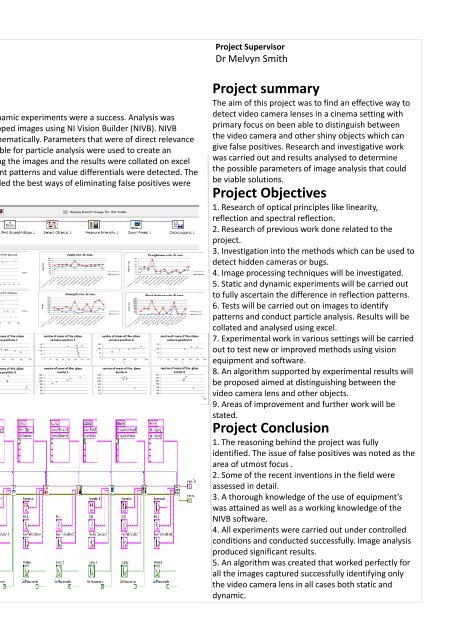UWE Bristol Engineering showcase 2015
You also want an ePaper? Increase the reach of your titles
YUMPU automatically turns print PDFs into web optimized ePapers that Google loves.
Christopher Ovaletor<br />
Meng Mechanical <strong>Engineering</strong><br />
Introduction<br />
There is a need to detect the lens of hidden cameras in order to eliminate<br />
piracy. One of the main problems is that of false positives, i.e. mistaking shiny<br />
objects within a busy scene for cameras. No method has yet been determined<br />
that deals with the issue of false positives and this project will involve<br />
extensive research into these application areas. Experimental work aimed at<br />
developing and testing a robust method for lens detection in a busy<br />
environment with emphasis on been able to distinguish between the lenses<br />
of a video camera and other objects will be undertaken. Research consisted of<br />
understanding the problems they pose, review and examination of current<br />
systems and/or machines been used to combat these problems. Experiments<br />
were conducted under controlled conditions and the images captured were<br />
analyzed for patterns and particle composition. An algorithm was created<br />
aimed at effectively distinguishing between video camera lenses and other<br />
test objects.<br />
Number of objects<br />
500<br />
450<br />
400<br />
350<br />
300<br />
250<br />
200<br />
150<br />
100<br />
50<br />
0<br />
Number of detected objects<br />
Hidden lens and camera detection<br />
Experiments<br />
In order to perform an initial analysis experiments were carried out on a<br />
wide variety of test objects that could be present in a setting where<br />
identification of hidden camera lenses was required. Measurements were<br />
made and the setting was kept controlled at all times. Both static and<br />
dynamic experiments were carried out. The dynamic experiments were<br />
carried out by marking 5 set positions on a straight line and moving the<br />
torchlight from left to right along the line.<br />
Analysis<br />
Both the static and dynamic experiments were a success. Analysis was<br />
carried out on the cropped images using NI Vision Builder (NIVB). NIVB<br />
interprets images mathematically. Parameters that were of direct relevance<br />
to the project i.e. suitable for particle analysis were used to create an<br />
algorithm for processing the images and the results were collated on excel<br />
and analysed. Significant patterns and value differentials were detected. The<br />
parameters that provided the best ways of eliminating false positives were<br />
noted.<br />
Project Supervisor<br />
Dr Melvyn Smith<br />
Project summary<br />
The aim of this project was to find an effective way to<br />
detect video camera lenses in a cinema setting with<br />
primary focus on been able to distinguish between<br />
the video camera and other shiny objects which can<br />
give false positives. Research and investigative work<br />
was carried out and results analysed to determine<br />
the possible parameters of image analysis that could<br />
be viable solutions.<br />
Project Objectives<br />
1. Research of optical principles like linearity,<br />
reflection and spectral reflection.<br />
2. Research of previous work done related to the<br />
project.<br />
3. Investigation into the methods which can be used to<br />
detect hidden cameras or bugs.<br />
4. Image processing techniques will be investigated.<br />
5. Static and dynamic experiments will be carried out<br />
to fully ascertain the difference in reflection patterns.<br />
6. Tests will be carried out on images to identify<br />
patterns and conduct particle analysis. Results will be<br />
collated and analysed using excel.<br />
7. Experimental work in various settings will be carried<br />
out to test new or improved methods using vision<br />
equipment and software.<br />
8. An algorithm supported by experimental results will<br />
be proposed aimed at distinguishing between the<br />
video camera lens and other objects.<br />
9. Areas of improvement and further work will be<br />
stated.<br />
Project Conclusion<br />
1. The reasoning behind the project was fully<br />
identified. The issue of false positives was noted as the<br />
area of utmost focus .<br />
2. Some of the recent inventions in the field were<br />
assessed in detail.<br />
3. A thorough knowledge of the use of equipment’s<br />
was attained as well as a working knowledge of the<br />
NIVB software.<br />
4. All experiments were carried out under controlled<br />
conditions and conducted successfully. Image analysis<br />
produced significant results.<br />
5. An algorithm was created that worked perfectly for<br />
all the images captured successfully identifying only<br />
the video camera lens in all cases both static and<br />
dynamic.


